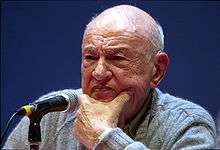Edgar Morin Centre
The Edgar Morin Centre (French: Centre Edgar Morin, previously CETSAH, Centre d’Études Transdisciplinaires, Sociologie, Anthropologie, Histoire) is a graduate teaching and research unit of the École des Hautes Études en Sciences Sociales and of the French Centre National de la Recherche Scientifique, Paris. Currently enjoying its fifth decade of activity, the Center (named after the internationally renowned social theorist Edgar Morin) is part of the Interdisciplinary Institute for the Anthropology of Contemporary Societies (IIAC).
History
The Edgar Morin Center was established in 1960 at the École Pratique des Hautes Études by French sociologist Georges Friedmann. Initially named Center for the Study of Mass Communications, it evolved into the CETSAH in 1973. Only in 2007 it was given its current name, as a tribute to Edgar Morin. Under the prestigious guidance and influence of Morin and of the late Roland Barthes, over the years the Centre has been producing research in such fields as sociology, cultural anthropology, semiotics, media studies, complexity studies, philosophy, history, political science and social psychology.
Research activities
Transdisciplinarity is the main feature of research at the Edgar Morin Centre. Typical research topics offer multiple potential entries. Food, for instance, is a basic function both in physiological and social terms. As another example, the body can and should be considered as a historical, medical, psychosocial, political, and social construct. All the teams apply this perspective to their specific topics. The Centre currently hosts about 80 researchers, doctoral and masters students.
Research teams are organised as follows:
| Research Team | Team Leader(s) | Team Members |
|---|---|---|
| The body, the individual and society | Georges Vigarello | Corinne Boujot, Jacqueline Carroy, Antonio Casilli, Jean-Pierre Castelain, Jean-Jacques Courtine, Gisèle Dambuyant-Wargny, Claudine Haroche, Rafael Mandressi, Véronique Nahoum-Grappe, Marie-Christine Pouchelle, Isabelle Queval, Eliane Rothier-Bautzer, Roger Sue |
| Food and eating: cross-cultural studies on perceptions and practices | Claude Fischler | Torbjörn Bildtgård, Corinne Boujot, Antonio Casilli, Saadi Lahlou, Estelle Masson, Jocelyn Raude, Sylvie Sanchez |
| Memory, identity, generations | Nicole Lapierre | Claudine Attias-Donfut, André Burguière, Marina Chauliac, Daniel Friedmann, Nicole Lapierre, Alfredo Pena-Vega, Martyne Perrot, Evelyne Ribert, Steven Uran |
| Nature, space, and environment | Geneviève Delbos, Martyne Perrot, Martin de la Soudière | Martine Bergues, Sophie Bobbé, Corinne Boujot, Jean-Pierre Castelain, Jacques Cloarec, Gisèle Dambuyant-Wargny, Emilie Giret, Bernard Paillard, Alfredo Pena-Vega. |
| Transdisciplinarity and complexity | Alfredo Pena-Vega | André Burguière, Emmanuel Banywesize, Antonio Casilli, Claude Fischler, Saadi Lahlou, Nicole Lapierre, Edgar Morin, Bernard Paillard, Georges Vigarello |
| Common sense, social representations and social influence | Elisabeth Lage | Lucy Baugnet, Magdalini Dargentas, Maria Geka, Saadi Lahlou, Laura Lima, Béatrice Madiot, Estelle Masson, Bernard Personnaz, Marie Personnaz |
| Applications of audiovisual tools to field research in the social sciences | Daniel Friedmann | Marc-François Deligne, Bernard Paillard, Alfredo Pena-Vega |
Teaching activities

The Centre is hosted by the EHESS, whose advanced programs are intended to lead to research careers. Masters and doctoral students are admitted by application. The main topics include: history, social psychology, sociology, ethnography, media studies, field methodologies, epistemology, environmental sciences.
Publishing
Since 1961, the Centre has been publishing the transdisciplinary journal Communications, which has regularly produced thematic issues featuring articles by prominent international intellectuals, social theorists and scientists. Among others: Roland Barthes, Umberto Eco, Moses Finley, Noam Chomsky, Tzvetan Todorov, Bill Viola, Paul Virilio, Raymond Boudon, Jacques Le Goff..